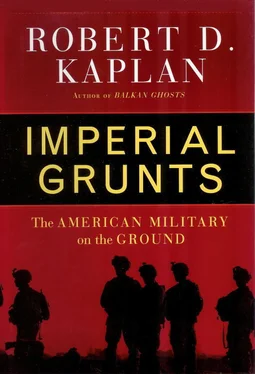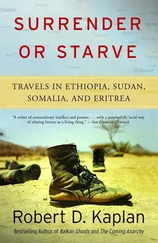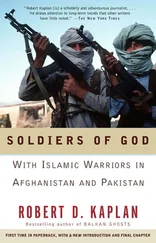Who here was al-Qaeda? I asked myself, licking my fingers after devouring a greasy chicken in a sidewalk restaurant filled with armed youngsters. Perhaps nobody. It didn’t matter. The point was that these foul, densely populated encampments in Yemen’s northern desert, adjoining the most unstable parts of Saudi Arabia, constituted a fertile petri dish within which radical groups such as al-Qaeda and its offspring could breed. Here was the demographic and cultural battlefield that the U.S. security establishment would have to penetrate. Similar battlefields lay all over the world.
———
The fact that Ma’rib was an oasis became noticeable only when I looked down on it from afar: from a sun-baked archaeological mound coated in moondust holding the crumbled debris of antiquity, with nineteenth-century mudbrick towers tilting crazily in each direction. The tourist stand had long collapsed. A few soldiers followed on foot close behind me. From the top of the mound I saw a thin band of drab vegetation.
For a thousand years, from the eighth century B.C., the great dam of Ma’rib, whose massive, honeycombed walls were still visible, joined with an elaborate system of terrace irrigation to make much of this desert truly green. Biblical Sheba (the Sabaean kingdom) had been part of an antique cluster of civilization every bit as fabulous as the Nile Valley in Egypt and the environs of Carthage in Tunisia. The pharaonic Egyptians called this corner of Arabia the Land of Punt; to the Hebrews it was Ophir. As I shall explain, Yemen’s internal disarray was a natural by-product of this history, which in turn was a result of geography.
Yemen, or Yaman, is a word of ancient connotation. In Arabic it literally means “right hand,” the part of Arabia south of the Gulf of Aqaba that, from the standpoint of Greco-Egyptian geographers like Ptolemy, lay to the “right” of Alexandria. Yemen, with a quarter of Saudi Arabia’s land area, yet with a population almost as large as Saudi Arabia’s, has since the classical age been the demographic core of the Arabian Peninsula. Here in the peninsula’s southwest corner sweeping basalt plateaus rear up into volcanic plugs and sandcastle formations, framing a network of oases that since antiquity has sustained large urban populations.
Separated from one another by mountain fastnesses, and rich from the production of funerary spices on the cliff sides, from 800 B.C. to A.D. 500 half a dozen tribal kingdoms in this part of Arabia (Sabaean, Hadhramauti, Himyarite) fought internecine wars, even as their merchants cultivated contacts with Africa and southern Asia. From India came diamonds and sapphires, lapis lazuli, and pepper; from Africa, ivory and ostrich feathers. Sabaean merchants and their rivals exported frankincense and myrrh at a time when such spices sweetened every funeral altar in the known world. Yemeni kingdoms grew rich on their individual strips of the great incense highway. Freya Stark writes that “they became imperial and aristocratic, builders of tall cities; they colonized Somaliland and Ethiopia.” 5Yet, because each was checked by the other, in spite of their imperial demeanor, none of them developed into an empire that was able to rule the whole of present-day Yemen.
These ancient kingdoms were followed by an equally bewildering assemblage of medieval Arab dynasties—Ziyadids, Zaydis, Rasulids, and so forth—both Shiite and Sunni, as each valley and oasis remained a sovereignty unto itself. Indeed, the Rasulid period from 1229 to 1454 stands out as the only example of effective government over most of Yemen through modern times. 6
The Ottoman Turks officially conquered Yemen in 1517. But their four-hundred-year hold over the interior was nothing but a series of bloody failures, with the Shiite Zaydis withdrawing into their mountain hideouts of northern Yemen following each victory. To the south, the British officers who manned the Aden Protectorate were kept busy maintaining short-lived truces among the Qu’aiti, Kathiri, and other tribes in the Hadhramaut and adjoining wadis. The historian Jan Morris mentions that “the last true expression of High Empire” for the British was the system of tenuous treaties among the Hadhramauti chieftains negotiated by Harold Ingrams of the Colonial Office and his adventurous wife, Doreen, which came to be known as the Sulh Ingrams (Ingram’s Peace). 7
But internecine violence never truly ceased. A civil war from 1962 to 1968 in northern Yemen, between the forces of a conservative imam and revolutionary officers supported by Gamal Abdel Nasser’s Egypt—a war which gradually disintegrated into the usual tribal feuding—claimed two hundred thousand lives before a military-run republic emerged. Meanwhile, in southern Yemen, Britain’s Aden Protectorate gave way to a Marxist state, where, in 1986, Moscow’s attempt to change the leadership of the Yemeni Communist party led to a month-long intertribal war in which ten thousand people were killed. As in Afghanistan, the Soviets found that Yemeni governments were easy to change but that once installed they were undermined by clan divides.
North and South Yemen officially united in 1990, as the South Yemeni state collapsed in the course of the worldwide dissolution of the Soviet empire. But unlike in Eastern Europe, the experiment with democracy failed here. Indeed, it led to another civil war in 1994, this time along north-south lines, in which the north emerged victorious; seven thousand people died in the fighting.
Ali Abdullah Saleh, a former army lieutenant colonel, took power in North Yemen in 1978. Though he couldn’t control all of this Afghanistan-like country, he was still doing better than the Turks or the British before him.
The anachronistic trinity of family, village, and tribe that has divided Yemen since antiquity had one positive element, though: it prevented the kind of stultifying, overly centralized tyranny existent in places like Iraq and Syria. And with no danger of Saleh becoming such a tyrant, the CENTCOM concept of training Yemeni elite units to project power in the cindery badlands held out the only hope of liberalization, through the extension of central authority. But to succeed, the three-thousand-year legacy of separate Yemeni kingdoms would have to be overcome.
———
We continued east, passing through the edge of the Empty Quarter, the utter desert that, while associated with Saudi Arabia, crept over into Yemen. It was late when we entered the Wadi Hadhramaut and stopped for salta, a spicy stew filled with beans and lentils. Reclining on a rush mat in the gaslit darkness, I noticed that the bread I had been served was similar to Indian nan, and that the men had darker, more oriental features than in Sana’a and Ma’rib. Instead of thobes they were wearing plaid loincloths, like men I had seen in India, Burma, and Indonesia. It was testimony to the copious family and trading links with South and Southeast Asia that Hadhramauti merchants had maintained for centuries; the Nizam of Hyderabad, in south-central India, recruited his bodyguards exclusively from Hadhramauti tribesmen. 8
Despite a history of insular tribal feuds, this hundred-mile-long oasis, inhabited since 1000 B.C., was part of a rich cosmopolitan world obscure to the West. The rise of radical Islam in Indonesia in our own time has its roots in Islamic learning centers established in the early eighteenth century by Hadhramauti traders, whose twenty-first-century business networks derive from those begun by the Sabaean and Himyaritic spice merchants of antiquity. 9Such networks offered convenient pathways for a group like al-Qaeda to conduct its financial operations, particularly as Osama bin Laden’s family came from the nearby Wadi Do’an. Caravan trails, revived by bin Laden’s organization, provided the Hadhramaut with direct links to Mecca and other places in Saudi Arabia.
Читать дальше












